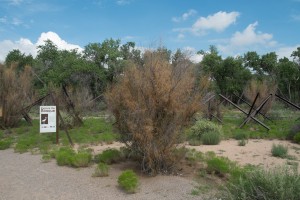
A tree hit by tamarisk beetles, Albuquerque’s Rio Grande bosque, July 2015, by John Fleck
The tamarisk beetle, introduced in 2001 as a strategy to control “invasive” tamarisk trees in the United States, is “expected to
spread throughout the entire (Colorado River Basin), and tamarisk presence, distribution and abundance will likely decline as a result,” according to a new report (pdf). “Tamarisk beetle in the Colorado River basin”, written by Ben Bloodworth of the Tamarisk Coalition, Pat Shafroth of the USGS, and colleagues, documents the findings of a major workshop last year.
The scare quotes around “invasive” are a reference to the issues raised by biologist Ken Thompson’s book Where are Camels From. Our ideas about “native” and “invasive” are in part social constructions, Thompson argues. How long has the newcomer been here? Do we “like” it or not? How do they fit into the changed environment we’ve created?
With the changed hydrology of dams and diversions on our western rivers, we’ve got a sufficiently altered system that the “native” biota we’re trying to protect are often ill suited to the new environment we’ve created. With tamarisk, that means that we now have “native” critters that do well in tamarisk because the old flood plain habitat in which they lived is gone, on account of no floods. Two key points from the report:
- Tamarisk beetles are expected to spread throughout the entire CRB, and tamarisk presence, distribution and abundance will likely decline as a result.
- The expected effects of this tamarisk decline on native plant species are dependent upon a number of environmental factors that may be useful in predicting outcomes. Most important is the degree to which the system has changed from historical conditions, including dynamism of the river, soil conditions, and the state of the remnant native plant community.
So for example the endangered willow flycatcher may suffer as a result. With its native habitat gone, it’s made a new life in the tamarisk, which will be harder now.
The report suggests that a more natural, spread out hydrologic system may be possible as tamarisk declines, but only in river systems that have something approximating their natural flow regime.

we are the great innoculators. we speed up the movement of species all over this planet faster than the weather, or geologic/plate techtonics would do, etc. soon i hope we innoculate a bunch of other planets in other solar systems. this thing called life is amazing.
as life is also mainly about water this fits very well with your studies. 🙂